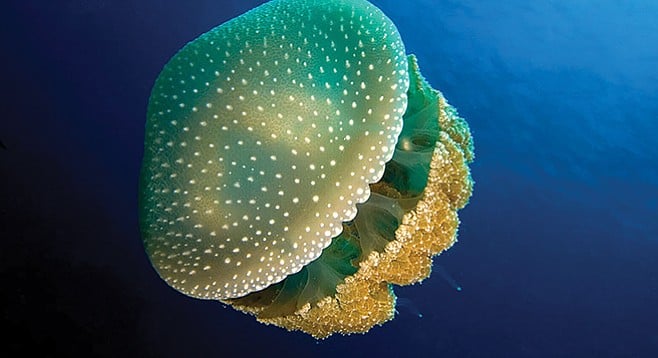 Facebook
Facebook
 X
X
 Instagram
Instagram
 TikTok
TikTok
 Youtube
Youtube

About 100 yards into an early-morning kayak-fishing excursion on September 28, Steve Piper noticed a plentiful presence on his fish finder. As he paddled out into San Diego Bay from the boat ramp at Pepper Park in Chula Vista, Piper saw a multitude of unusual-looking jellies bobbing in the water at five- to twenty-foot intervals. He snapped a photo and emailed it to colleagues at Scripps Institution of Oceanography, who identified it as the white-spotted jellyfish, Phyllorhiza punctata.
The Australian species is invasive in San Diego waters and most likely came to town in the ballast tank of a ship. Aquarist Mike Rinaudo of Birch Aquarium said the jellies were first spotted in San Diego Bay in the 1980s, and populations tend to increase when the water is warm. Piper noted that when he observed the floating bells the water temperature was 80 degrees. That’s well above average for this time of year in this latitude.
Though they have a mild sting and are not particularly harmful to humans (and few people swim in San Diego Bay), white-spotted jellies are filter feeders and an abundance of them can affect the plankton populations that other species feed on. With bells up to 20 inches, these jellies filter large amounts of water.
Specimens collected from San Diego Bay are now on exhibit at Birch Aquarium.


About 100 yards into an early-morning kayak-fishing excursion on September 28, Steve Piper noticed a plentiful presence on his fish finder. As he paddled out into San Diego Bay from the boat ramp at Pepper Park in Chula Vista, Piper saw a multitude of unusual-looking jellies bobbing in the water at five- to twenty-foot intervals. He snapped a photo and emailed it to colleagues at Scripps Institution of Oceanography, who identified it as the white-spotted jellyfish, Phyllorhiza punctata.
The Australian species is invasive in San Diego waters and most likely came to town in the ballast tank of a ship. Aquarist Mike Rinaudo of Birch Aquarium said the jellies were first spotted in San Diego Bay in the 1980s, and populations tend to increase when the water is warm. Piper noted that when he observed the floating bells the water temperature was 80 degrees. That’s well above average for this time of year in this latitude.
Though they have a mild sting and are not particularly harmful to humans (and few people swim in San Diego Bay), white-spotted jellies are filter feeders and an abundance of them can affect the plankton populations that other species feed on. With bells up to 20 inches, these jellies filter large amounts of water.
Specimens collected from San Diego Bay are now on exhibit at Birch Aquarium.
Comments